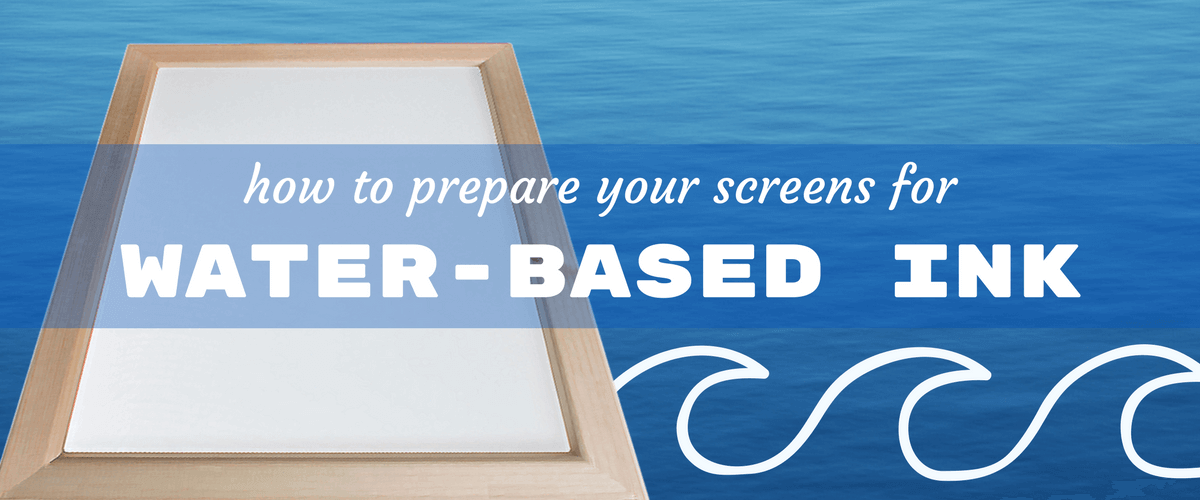No products in the cart.
en

Revolutionizing the screen printing industry through cutting-edge technology and quality service
Phone: +1 847-367-9760
Anatol Equipment Manufacturing Co.
1429 S Shields Dr
Waukegan, IL 60085

Revolutionizing the screen printing industry through cutting-edge technology and quality service
Anatol Equipment Manufacturing Co.
1429 S Shields Dr
Waukegan, IL 60085

Learn how to overcome one of water-based ink’s biggest challenges – maintaining a sturdy stencil! It’s a frustrating problem, for sure: You follow the proper steps for preparing your screens, but as you print, the stencil edge becomes soggy and wavy, and your prints can blur.
It’s a reality that your stencils will break down while using water-based ink; all emulsions are water soluble. As you print, whether with water-based inks or plastisol inks, the emulsion will absorb water and begin to deteriorate. However, you can slow that breakdown by properly preparing your screens for printing with water-based inks.
You probably know that water-based inks require a finer mesh count. Because of its lower viscosity, water-based ink travels fairly easy through mesh, and the higher mesh count prevents the ink from flooding the substrate. In addition to choosing a mesh count between 150 and 160 for typical prints and up to 225 for halftones, you want to choose a screen mesh that comprises thinner threads. A mesh made with finer threads provides the water-based ink with an easy tunnel to pass through on the way to your substrate. When the mesh is made of thicker thread, the water-based ink becomes trapped in between the mesh. Water-based ink that becomes trapped can dry and clog screens during press runs; that trapped ink also hastens the breakdown of the cured emulsion.
This step shouldn’t be skipped regardless of which type of ink you’re printing with, but it becomes especially important when printing with water-based inks. Before you begin to process your screens, make sure they’re free of any debris. Use a commercial degreaser to make sure there’s nothing on the screen that will prevent the emulsion from adhering properly. When printing with water-based ink, any weakness in the cured emulsion is going to lead to a more rapid breakdown of the stencil.
As we mentioned, all emulsions are water soluble, so any emulsion will break down from exposure to water-based inks eventually. That’s not to say that some emulsions aren’t better suited to screen printing with water-based inks. There are water-resistant emulsions and emulsions that are specifically formulated for use with water-based inks. Choosing a water-resistant emulsion or one marketed for use with water-based inks will help to prevent your stencil from breaking down prematurely. After you’ve coated your screens with emulsion, make sure they’re stored properly in a cool, dry, clean room.
You need properly exposed screens to create crisp prints, that goes without saying. But screen exposure is especially crucial when printing with water-based inks. Printing with water-based inks will reveal any flaws in the exposure process. Your film positive needs to be completely opaque, and you need a reliable exposure unit.

Anatol’s Aurora exposure unit produces
crisp stencils with speed and efficiency.
Know the proper exposure time for your emulsion in your exposure unit – an exposure calculator is a handy device to help you calculate required time. If you suspect during rinse out that your emulsion hasn’t entirely cured, don’t push your screen through to production; the water-based ink will quickly break down the detail and edges of your stencil.
If you want to give your screen extra protection against breakdown from water-based inks, consider taking the extra step of hardening your finished screen. There are two ways to do this. First, you can re-expose your screen in your exposure unit to ensure that the emulsion is fully cured and ready to stand up to water-based ink. Or, you can rely on a commercial hardening agent designed specifically for reinforcing stencils for screen printing.
Those who print with water-based ink know that stencil breakdown is inevitable. By using the proper materials and techniques, however, you can save yourself the frustration of having screens break down prematurely – saving you the trouble of dealing with blurry prints and making new screens for the same job.
For some more tips on using water-based screen printing ink, check out these blog posts:
Your message was successfully sent!
Leave a Comment
What kind of inventory management programs do you like?
Hi Tabitha,
I personally do not have any experience using shop management software to manage inventory, but I’ve heard good things from users of programs like Shopvox, Shopworks and Printavo. I’d recommend you apply for some free trials and see which program is easiest for you to use and meets the needs of your business best.
Alex